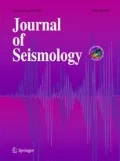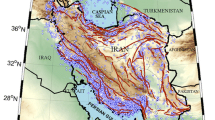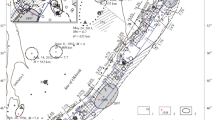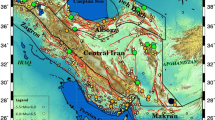Abstract
Earthquake occurrence and recurrence depend on number of factors beyond mere observations. These include seismotectonic nature of the region, spreading rate of the ridge or subduction of plates causing the trench, active or otherwise nature of the fault on crust (on land), stress-strain regime, and so on. In this work, the recurrence and expected times of next strong earthquakes (M ≥ 6) in the oceanic ridges and trenches were computed using gamma and lognormal probabilistic models. Summing the occurrence times of last strong earthquakes and these recurrence times, expected times of the next strong earthquakes were retrospectively and forwardly predicted. The expected times of the next strong earthquakes retrospectively predicted correlated with the recorded strong earthquakes in the earthquake catalog of the Advance National Seismic System (ANSS) hosted by the Northern California Earthquake Data Centre, USA, for the period of 1978–2017 in a readable format. The successful prediction of the expected times of the next strong earthquakes retrospectively is an indication that the expected times of the next strong earthquakes forwardly predicted in the regions of study will be positive. However, since the occurrence and recurrence of earthquakes depend on many factors, it is therefore important to note that it may not always be accurate to predict future earthquakes from retrospective perspective. Nonetheless, this work is a good effort, and it has thrown up some interesting results.

Similar content being viewed by others
References
Adagunodo TA, Oyeyemi KD, Hammed OS, Bansal AR, Omidiora JO, Pararas-Carayannis G (2018) Seismicity anomalies of M 5.0 + earthquakes in Chile during 1965–2015. Sci Tsunami Hazards 37(2):130–156 http://www.tsunamisociety.org/STHVol37N2Y2018.pdf
Chen C-H, Wang J-P, Wu Y-M, Chan C-H, Chang C-H (2012) A study of earthquake inter-occurrence times distribution models in Taiwan. Nat Hazards 69:1335–1350. https://doi.org/10.1007/s11069-012-0496-7
Cluff LS, Patwardhan AS, Coppersmith KJ (1980) Estimating the probability of occurrence of surface faulting earthquakes on the Wasatch fault zone, Utah. Bull Seismol Soc Am 70:463–478
Cornell CA (1968) Engineering seismic risk analysis. Bull Seismol Soc Am 58:1583–1160
Devi A, Kalita S (2013) Return period analysis of earthquakes of northeast India and its adjoining region. Int J Eng Sci Invent 2(7):15–28 ISSN (online) 2319–6734, ISSN (print) 2319–6726
Ferráes SG (2005) A probabilistic prediction of the next strong earthquake in the Acapulco-San Marcos segment, Mexico. Geofis Int 44(4):347–353
Hagiwara Y (1974) Probability of earthquake occurrence as obtained from a Weibull distribution analysis of crustal strain. Tectonophysics 23:313–318
Hammed OS, Popoola OI, Adetoyinbo AA, Awoyemi MO, Badmus GO, Ohwo OB (2013) Focal depth, magnitude, and frequency distribution of earthquakes along oceanic trenches. Earthq Sci 26:75–82
Hammed OS, Adagunodo TA, Awoyemi MO, Arogundade AB, Ajama OD, Sapele FO, Usikalu MR, Olanrewaju AM, Akinwumi SA, Ogunwale EI (2019) Identification of tsunamigenic earthquake zones in oceanic ridges and trenches. Sci Tsunami Hazards 38(2):103–117 http://tsunamisociety.org/STHVol38N2Y2019.pdf
Isacks B, Oliver J, Sykes LR (1968) Seismology and the new global tectonics. J Geophys Res 73:5855–5899
Jacoby WR (January 1981) Modern concepts of earth dynamics anticipated by Alfred Wegener in 1912. Geology 9:25–27. https://doi.org/10.1130/00917613(1981)9<25:MCOEDA>
Knopoff L, Kagan Y (1977) Analysis of the theory of extremes as applied to earthquake problems. J Geophys Res 82:5647–5657
Ladd JW, Holcombe TL, Westbrook GK, Edgar NT (1990) Caribbean marine geology: active margins of the plate boundary. In: Dengo G, Case J (eds) The geology of North America: the Caribbean region, vol H. Geological Society of America, Boulder, pp 261–290
LePichon X, Francheteau J, Bonnin J (1973) Plate tectonics. Elsevier, Amsterdam
Marjorie W (1993) Igneous petrogenesis. Chapman & Hall, London ISBN 9780412533105
Matias LM, Cunha T, Annunziato A, Baptista MA, Carrilho F (2013) Tsunamigenic earthquakes in the Gulf of Cadiz: fault model and recurrence. Nat Hazards Earth Syst Sci 13:1–13
McNally KB, Minster JB (1981) Non-uniform seismic slip rates along the Middle American Trench. J Geophys Res 86:4949–4959
Mishra OP, Zhao D, Umino N, Hasegawa A (2003) Tomography of northeast Japan forearc and its implications for interpolate seismic coupling. Geophys Res Lett 30(16):1850. https://doi.org/10.1029/2003GL017736
Morgan WJ (1972) Plate motions and deep mantle convection. Geol Soc Am Mem 132:7
Nishenko SP, Buland R (1987) A generic recurrence interval distribution for earthquake forecasting. Bull Seismol Soc Am 77:1382–1399
Papadakis G Vallianatos F, Michas G (2013). The earthquake inter - event time distribution along the hellenic subduction zone. Bulletin of the Geological Society of Greece, vol. XLVII. Proceedings of the 13th International Congress, Chania, Sept. 2013
Pararas-Carayannis G (2007) The earthquake and tsunami of 2 September 1992 in Nicaragua. Archived from the original on 17 May 2008. Retrieved 2008-06-09
Pararas-Carayannis G (2011) The earthquake and tsunami of July 21, 365 AD in the Eastern Mediterranean Sea - review of impact on the ancient world - assessment of recurrence and future impact. 30(4):286
Parvez IA, Ram A (1997) Probabilistic assessment of earthquake hazards in the Northeast India peninsula and Hindukush regions. Pure Appl Geophys 149:731–746
Parvez IA, Ram A (1999) Probabilistic assessment of earthquake hazards in the Indian subcontinent. Pure Appl Geophys 154:23–40
Rikitake T (1976) Recurrence of great earthquakes at subduction zones. Tectonophysics 35:305–362
Sil A, Sitharam TG, Syed TH (2015) Probabilistic models for forecasting earthquakes in the northeast region of India. Bull Seismol Soc Am 105(6):2910–2927. https://doi.org/10.1785/0120140361
Smith WHF, Sandwell DT (1997) Global sea floor topography from satellite altimetry andship depth soundings. Science 277(5334):1956–1962
Stern RJ (2002) Subduction zones. Rev Geophys 40(4):1012. https://doi.org/10.1029/2001RG000108
Tsuboi S (2000) Application of Mwp to tsunami earthquake. Geophys Res Lett. American Geophysical Union. 27(19). Bibcode:2000GeoRL.27.3105T. doi:https://doi.org/10.1029/2000GL011735. Retrieved 19 July 2011
Utsu T (1984) Estimation of parameters for recurrence models of earthquakes. Bull Earthq Res Inst, Univ Tokyo 59:53–66
Yadav RBS, Tripathi JN, Rastogi BK, Das MC, Chopra S (2010) Probabilistic assessment of earthquake recurrence in Northeast India and adjoining regions. Pure Appl Geophys 167(11):1331–1342. https://doi.org/10.1007/s00024-010-0105-1
Zafarani H, Ghafoori MM (2013) Probabilistic assessment of strong earthquake recurrence in the Iranian plateau. J Earthq Eng 17(3):449–467
Acknowledgments
We sincerely acknowledge the professional contributions of the handling editor and the reviewers of this article.
Author information
Authors and Affiliations
Corresponding author
Additional information
Publisher’s note
Springer Nature remains neutral with regard to jurisdictional claims in published maps and institutional affiliations.
Rights and permissions
About this article
Cite this article
Hammed, O.S., Adagunodo, T.A., Fagbemigun, T.S. et al. Retrospective and forward prediction of next strong earthquakes in oceanic ridges and trenches using probabilistic models. J Seismol 24, 1225–1234 (2020). https://doi.org/10.1007/s10950-020-09938-z
Received:
Accepted:
Published:
Issue Date:
DOI: https://doi.org/10.1007/s10950-020-09938-z




